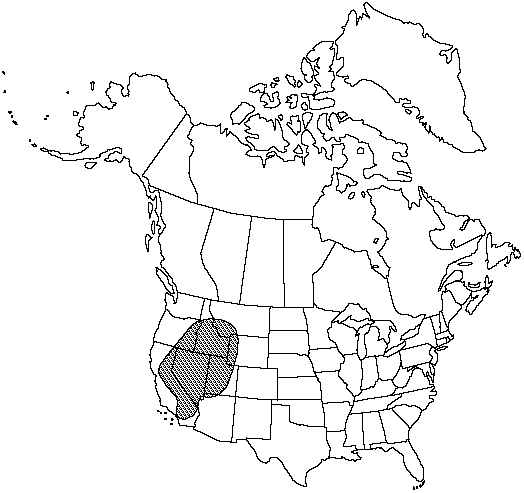Difference between revisions of "Selaginella watsonii"
Bull. Torrey Bot. Club 25: 127. 1898.
FNA>Volume Importer |
imported>Volume Importer |
||
| (7 intermediate revisions by 2 users not shown) | |||
| Line 8: | Line 8: | ||
}} | }} | ||
|common_names=Alpine spike-moss;Watson's spike-moss | |common_names=Alpine spike-moss;Watson's spike-moss | ||
| + | |special_status={{Treatment/ID/Special_status | ||
| + | |code=E | ||
| + | |label=Endemic | ||
| + | }} | ||
|basionyms= | |basionyms= | ||
|synonyms= | |synonyms= | ||
| Line 17: | Line 21: | ||
}}<!-- | }}<!-- | ||
| − | --><span class="statement" id="st- | + | --><span class="statement" id="st-undefined" data-properties=""><b>Plants </b>on rock or terrestrial, forming long or compact cushionlike mats. <b>Stems</b> radially symmetric, decumbent to long-creeping, not readily fragmenting, irregularly forked, without budlike arrested branches, tips straight; main stem conspicuously determinate, lateral branches conspicuously or inconspicuously determinate, strongly ascending, 1–3-forked. <b>Rhizophores</b> borne on upperside of stems, throughout stem length, 0.35–0.55 mm diam. <b>Leaves</b> monomorphic, in alternate pseudowhorls of 4, tightly or loosely appressed, ascending, green, linear-lanceolate, (2.5–)3–4 × 0.5–0.7 mm; abaxial ridges prominent; base cuneate, decurrent, glabrous or sometimes pubescent; margins entire or short-ciliate, cilia transparent, scattered, spreading, 0.05–0.1 mm; apex strongly keeled, obtuse, abruptly bristled; bristle whitish to transparent, smooth, 0.25–0.5 mm. <b>Strobili</b> solitary, 0.5–3(–3.5) cm; sporophylls lanceolate to ovate-lanceolate, abaxial ridges well defined, base glabrous, margins entire, rarely dentate, apex strongly keeled to truncate in profile, short-bristled.</span><!-- |
-->{{Treatment/Body | -->{{Treatment/Body | ||
| Line 23: | Line 27: | ||
|elevation=1800–4300 m | |elevation=1800–4300 m | ||
|distribution=Ariz.;Calif.;Idaho;Mont.;Nev.;Oreg.;Utah;Wyo. | |distribution=Ariz.;Calif.;Idaho;Mont.;Nev.;Oreg.;Utah;Wyo. | ||
| − | |discussion=<p>R. M. Tryon (1955) suggested that Selaginella watsonii is a possible ancestor of (or shares a common ancestor with) S. leucobryoides, S. asprella, and S. utahensis (see discussion).</p> | + | |discussion=<p>R. M. Tryon (1955) suggested that <i>Selaginella watsonii</i> is a possible ancestor of (or shares a common ancestor with) <i>S. leucobryoides</i>, <i>S. asprella</i>, and <i>S. utahensis</i> (see discussion).</p> |
|tables= | |tables= | ||
|references= | |references= | ||
| Line 32: | Line 36: | ||
-->{{#Taxon: | -->{{#Taxon: | ||
name=Selaginella watsonii | name=Selaginella watsonii | ||
| − | |||
|authority=L. Underwood | |authority=L. Underwood | ||
|rank=species | |rank=species | ||
| Line 45: | Line 48: | ||
|publication title=Bull. Torrey Bot. Club | |publication title=Bull. Torrey Bot. Club | ||
|publication year=1898 | |publication year=1898 | ||
| − | |special status= | + | |special status=Endemic |
| − | |source xml=https:// | + | |source xml=https://bitbucket.org/aafc-mbb/fna-data-curation/src/2e0870ddd59836b60bcf96646a41e87ea5a5943a/coarse_grained_fna_xml/V2/V2_579.xml |
|genus=Selaginella | |genus=Selaginella | ||
|subgenus=Selaginella subg. Tetragonostachys | |subgenus=Selaginella subg. Tetragonostachys | ||
|species=Selaginella watsonii | |species=Selaginella watsonii | ||
| − | |||
| − | |||
| − | |||
| − | |||
| − | |||
| − | |||
| − | |||
| − | |||
| − | |||
| − | |||
| − | |||
| − | |||
| − | |||
| − | |||
| − | |||
| − | |||
| − | |||
| − | |||
| − | |||
| − | |||
| − | |||
| − | |||
| − | |||
| − | |||
| − | |||
| − | |||
| − | |||
| − | |||
| − | |||
| − | |||
| − | |||
| − | |||
| − | |||
| − | |||
| − | |||
| − | |||
| − | |||
| − | |||
| − | |||
| − | |||
}}<!-- | }}<!-- | ||
-->[[Category:Treatment]][[Category:Selaginella subg. Tetragonostachys]] | -->[[Category:Treatment]][[Category:Selaginella subg. Tetragonostachys]] | ||
Latest revision as of 20:24, 5 November 2020
Plants on rock or terrestrial, forming long or compact cushionlike mats. Stems radially symmetric, decumbent to long-creeping, not readily fragmenting, irregularly forked, without budlike arrested branches, tips straight; main stem conspicuously determinate, lateral branches conspicuously or inconspicuously determinate, strongly ascending, 1–3-forked. Rhizophores borne on upperside of stems, throughout stem length, 0.35–0.55 mm diam. Leaves monomorphic, in alternate pseudowhorls of 4, tightly or loosely appressed, ascending, green, linear-lanceolate, (2.5–)3–4 × 0.5–0.7 mm; abaxial ridges prominent; base cuneate, decurrent, glabrous or sometimes pubescent; margins entire or short-ciliate, cilia transparent, scattered, spreading, 0.05–0.1 mm; apex strongly keeled, obtuse, abruptly bristled; bristle whitish to transparent, smooth, 0.25–0.5 mm. Strobili solitary, 0.5–3(–3.5) cm; sporophylls lanceolate to ovate-lanceolate, abaxial ridges well defined, base glabrous, margins entire, rarely dentate, apex strongly keeled to truncate in profile, short-bristled.
Habitat: On exposed or shaded cliffs, rocky slopes, rock crevices, granite boulders, quartzite rock, gravelly or sandy soil, alpine meadows, or swampy grounds
Elevation: 1800–4300 m
Distribution

Ariz., Calif., Idaho, Mont., Nev., Oreg., Utah, Wyo.
Discussion
R. M. Tryon (1955) suggested that Selaginella watsonii is a possible ancestor of (or shares a common ancestor with) S. leucobryoides, S. asprella, and S. utahensis (see discussion).
Selected References
None.